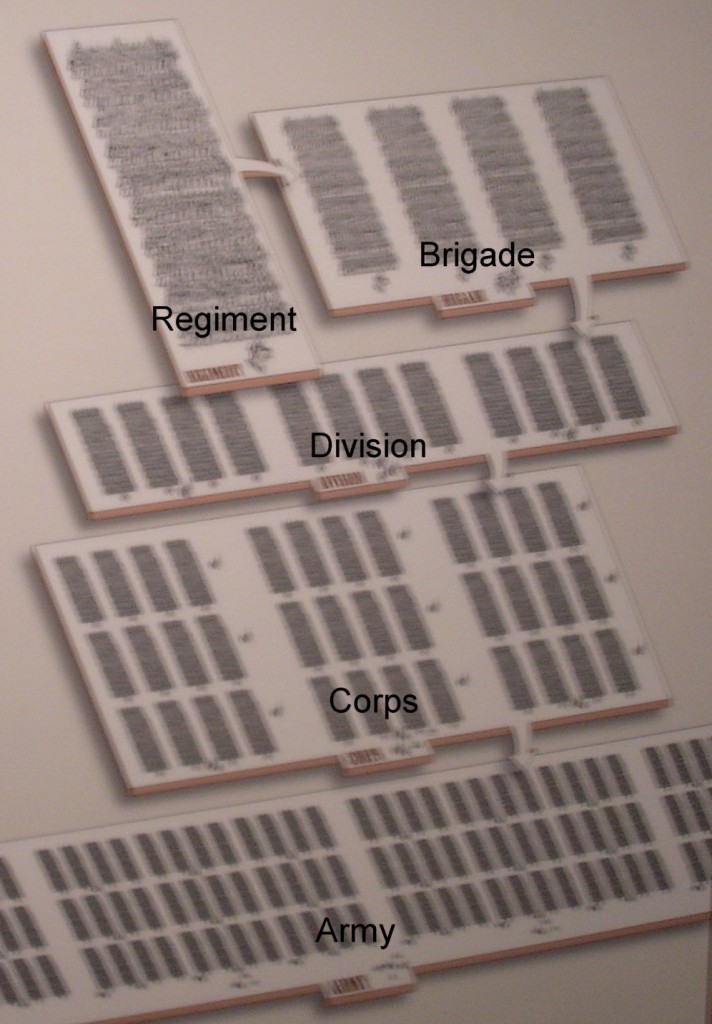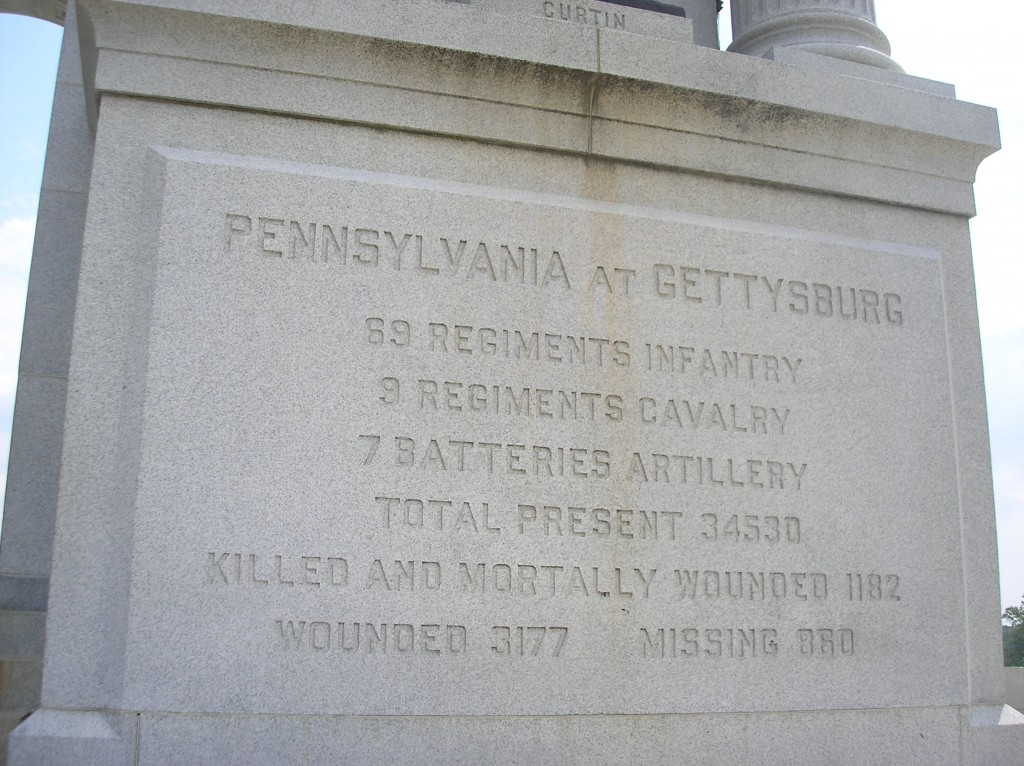Pennsylvania Regiments at Gettysburg – The Makeup of an Army
Posted By Norman Gasbarro on January 13, 2011
(Part 1 of an on-going series of posts on the Battle of Gettysburg).
The Battle of Gettysburg, fought 1 July to 3 July 1863, was considered a major turning point in the Civil War. It was a major defeat for Confederate Gen. Robert E. Lee and a victory for Union Gen. George G. Meade. While accurate figures may never be ascertained, it is estimated with some degree of correctness that about 93,534 Union solidiers in the Army of the Potomac fought against 70,226 Confederate soldiers in the Army of Northern Virginia. Casualties (killed, wounded, missing, taken prisoner) on the Confederate side numbered 22,874 and on the Union side 22,813.
The Union Army of the Potomac was organized into a series of “corps.” A corps consisted of about 9,000 to 13,000 soldiers. Within each corps, there were several divisions of between 3,000 to 5,000 men each. Within each division, there were 2 to 4 brigades. A brigade consisted of 4 to 5 regiments, which during the Civil War, were mostly supplied by the various states and bore a number followed by the name of the state – and sometimes the word “drafted” or “volunteer” indicating how the men became part of the regiment. Within the regiment, there could be 10 or more companies, each usually given a letter designation, e.g., “Company B.” There were also various levels of the headquarters staffs – the army staff commanded by Gen. Meade was the highest level, but regiments also had headquarters staffs, usually appearing in the listing as “Company HQ.”
The chart above is from the Civil War Museum at Gettysburg and shows an army organizational chart. In this example, starting from upper left is the regiment (consisting of several companies). Four regiments make a brigade. Three brigades make a division. Several divisions make an army.
Army corps were usually commanded by a “Major General,” divisions by a “Brigadier General,” brigades by a “Brigadier General” or a “Colonel,” regiments by a “Major,” a “Colonel,” or a “Captain,” and companies by a “Captain.” Within the brigades, there were often regiments from several states. Most of the Pennsylvania regiments were “infantry” (foot soldiers), but there were also artillery regiments, cavalry regiments, and reserve regiments.
In determining whether a specific soldier from the Lykens Valley area was present at Gettysburg during the time of the battle, the first step would be to determine whether the regiment was present at the battle. The second step is to determine whether the Battle of Gettysburg falls within the soldier’s service dates (“muster in” to “muster out”). Finally, the actual military record should be consulted to determine whether the soldier was active duty at the time of the battle. This final step is important because some soldiers were temporarily excused from duty because they were ill or wounded. Some soldiers deserted. Some may have been on approved leave.
At this point in the Civil War Project, about 2000 Civil War veterans have been identified from the Greater Lykens Valley area. Of these 2000 veterans, more than two-thirds have been connected to one or more specific regiments and companies, and in the cases where they have been connected to a specific regiment and company it is possible to state whether or not the Battle of Gettysburg fell within their service date range. Since very few few actual military records have been obtained so far, the “final” step cannot be done at this time.
According to information on the Pennsylvania Monument at Gettysburg, 69 regiments of Pennsylvania infantry, 9 regiments of Pennsylvania cavalry, and 7 batteries of Pennsylvania artillery fought in the battle. Pennsylvania supplied 34,530 men, of whom 1182 were killed or mortally wounded, 3177 were wounded, and 860 were missing.
Information on the organization of the Union and Confederate armies at Gettysburg, the number of men who fought in each army, and the names of the Pennsylvania regiments was gleaned from Gettysburg: A Testing of Courage, by Noah Andre Trudeau, 2002, Harper Collins, pages 565-595. The names of the Pennsylvania regiments and the names of the Pennsylvania men who fought at Gettysburg are also on bronze tablets on the Pennsylvania Monument at Gettysburg.
 ;
;




This is the best blog for anyone who wants to search out out about this topic. You notice so much its almost hard to argue with you (not that I actually would need…). You undoubtedly put a brand new spin on a topic tha’ts been written about for years. Nice stuff, just great!
I have a Civil War Diary that was kept by my ancestor, Joseph Bell Todd, who served under the command of Robert B. Hampton’s Battery F Independent Pennsylvania Light Artillary from 10/20/1861 to 07/29/1863. Lt. Todd was in every major battle including Antietam and Gettysburg. He was shot off his horse and taken to Newport Hospital in Rhode Island. I would like to publish this diary; however, I need to know more about Lt. Todd first. Can someone help me find resources please??
On ancestry.com I discovered that my great grandfather fought in the civil war – 29th Regiment, company A – I would love to know if his name is on that Gettysburg Monument – I believe he was in that battle – how to dig deeper??? Thx
the casualty figures above from the Pennsylvania State monument agree with Stone Sentinels and others…but somewhere along the pike, I was under the impression that Busey and Martin’s ‘Regimental Strengths and Losses at Gettysburg’ was considered the Bible on casualties…and on page 275, chart 6.16 ‘Union Strengths and Losses By State’, Pennsylvania is listed: engaged strength: 23424; total loss (k-w-m): 5886; percent loss: 25.1%…a long way from the figures cited on the monument and a percentage of 15.1%
can you shed any light on the obvious discrepancies … or give me your untrammeled opinion…thank you and I remain, and have the honor to be, your obdt srvt….Mark Gade